The CLEAN Future Act and Oilfield-produced Water Regulation: Potential Consequences for the U.S. and Global Energy Transition

Table of Contents
Author(s)
Share this Publication
- Download PDF
- Print This Publication
- Cite This Publication Copy Citation
Collins, Gabriel. 2021. The CLEAN Future Act and Oilfield-Produced Water Regulation: Potential Consequences for the U.S. and Global Energy Transition. Baker Institute Report no. 06.11.21. Rice University’s Baker Institute for Public Policy, Houston, Texas.
Introduction
The Climate Leadership and Environmental Action for our Nation’s Future Act (CLEAN Future Act) seeks to transform the United States into “a 100% clean economy by not later than 2050.”1 Testimony heard to date by the House Committee on Energy and Commerce concerning the CLEAN Future Act has included subjects such as the “Buy Clean” procurement provisions, low-carbon renewable process heat for industries, the impacts of federal infrastructure policy, transport decarbonization, Superfund issues, energy resilience, and social and economic equity.2
While substantial, the testimonial record for the CLEAN Future Act still has not addressed the systemic domestic and global energy security and economic impacts of its proposed provisions concerning oilfield-produced water. Section 625 of the act holds particular importance, as it would task the administrator of the U.S. Environmental Protection Agency (EPA) with determining whether certain oil and gas production byproducts—including produced water—“meet the criteria promulgated under this section for the identification or listing of hazardous waste” within one year of the bill’s enactment.3 The EPA defines produced water as “the water (brine) brought up from the hydrocarbon-bearing strata during the extraction of oil and gas.”4
Timing and framing provide important context. In 2019, the EPA affirmed its prior determination that produced water was not a hazardous waste. The Resource Conservation and Recovery Act (RCRA) presently requires the EPA to review its classification of oilfield-produced water at least every three years—meaning the next determination is due in 2022.5 Existing requirements notwithstanding, the CLEAN Future Act demands that the EPA review produced water’s RCRA status within one year of the bill’s enactment (assuming passage). This tight timeline, proposed under the section heading of “Closing Loopholes and Ending Arbitrary and Needless Evasion of Regulations,” reasonably raises the question of whether the drafters seek a specific outcome—in this case, presumably the classification of produced water as a hazardous waste.6
Figure 1 — RCRA Produced Water Regulatory Timeline vs. U.S. Domestic Oil and Gas Production
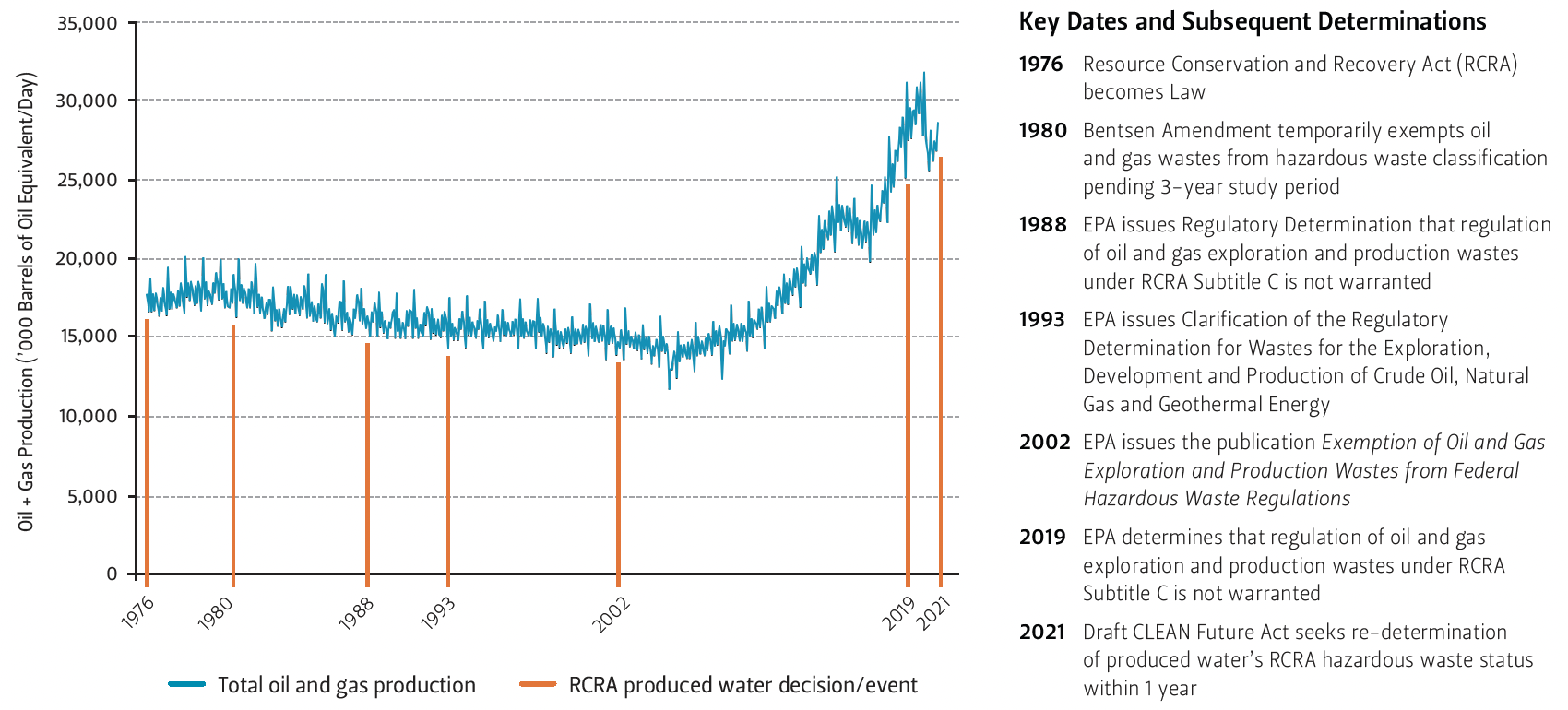
As the legislation is being discussed, it is worth considering at least five core risk factors that could potentially create globally-impactful, adverse consequences if the EPA broke with more than 40 years of historical precedent and determined that produced water was a “hazardous waste.”7
High-probability Adverse Consequences of Classifying Produced Water as a Hazardous Waste
Risk Factor 1: Oil and Gas Are Critical Energy Transition Minerals
America’s energy future in 2100 will likely be as different from today’s energy environment as our current mix is from what we consumed in 1900. Yet regardless of the path that unfolds, the purely empirical reality is that oil and gas will likely be a part of the U.S. and global energy portfolios for many years to come—even if they are increasingly disfavored by certain political constituencies. Scale and legacy are powerful forces, and “organic” energy transitions driven by market forces and superiority of new sources typically take decades to unfold (Figure 2).
Oil and gas combined still account for about two-thirds of the United States’ primary energy consumption and just under 60% of global primary energy use.8 As Michelle Michot Foss, the fellow in energy, minerals, and materials at Rice University’s Baker Institute for Public Policy, has noted, “hydrocarbons are critical minerals.”9 Accordingly, they will play an essential role in the cost, speed, and success of the ongoing transition to a lower net-carbon energy future.
Accessing these essential resources requires producers to also manage water molecules trapped alongside the hydrocarbons in underground reservoirs. Just as copper and iron ore miners must manage overburden and tailings, so oil and gas producers must find ways to cost-effectively (and safely) deal with produced water.
Classifying produced water as a hazardous waste would end the ability to use Class II injection disposal wells, whose regulation is generally delegated by the EPA to state agencies—for instance, the Oil Conservation Division in New Mexico and the Railroad Commission in Texas.
Since produced water is not classified as a hazardous waste subject to RCRA Subtitle C, parties seeking to inject it can avail themselves of the approximately 180,000 Class II wells currently in service throughout the United States.10 In contrast, if produced water were classified as a hazardous waste, it would have to be disposed of in Class I disposal wells permitted for hazardous waste, of which fewer than 200 currently exist, with fewer still that actually accept third-party hazardous waste generated offsite.11 To boot, much of this meager capacity resides along the Texas and Louisiana Gulf Coast—hundreds of miles from key oil and gas production plays such as the Eagle Ford shale and the Permian Basin—with no water pipelines to move water volumes that collectively exceed 10 million barrels per day.
As such, if produced water were classified as a hazardous waste, oil and gas producers would have to contend with severe disposal capacity constraints as well as an enormous set of associated obligations. These include: (1) being classified as large quantity generators of hazardous waste, (2) meeting cradle-to-grave waste management obligations, and (3) contending with additional strictures imposed by other statutes such as the Comprehensive Environmental Response, Compensation, and Liability Act, the Clean Air Act, the Clean Water Act, and the Emergency Planning and Community Right-to-Know Act.12
The resulting economic impacts would be profound—and likely, existential. Oilfield water management costs would likely rise five- to 10-fold from current levels. Commercial Class II saltwater disposal facilities generally charge $0.50 to $1.00 per barrel of water injected, while Class I wells handling non-hazardous waste, such as landfill leachate, charge $7.50 to $10.50 per barrel injected.13 Rates for Class I injection wells permitted for hazardous wastes would likely be even higher due to their relative scarcity—if the well owners would (or could) accept produced water generated offsite.
This could very plausibly create a situation in which many U.S. oil and gas operators—who contend with as many as 10 barrels of water per barrel of oil produced—wind up paying fees to dispose of produced water that exceed the gross revenues earned for the hydrocarbons they are producing.14 Intensified economic burdens plus exponentially magnified environmental, social, and governance liabilities would discourage oil and gas production and perhaps even impact existing producing assets.
Figure 2 — Energy Transition Has Been Underway for Two Centuries: U.S. Primary Energy Sources
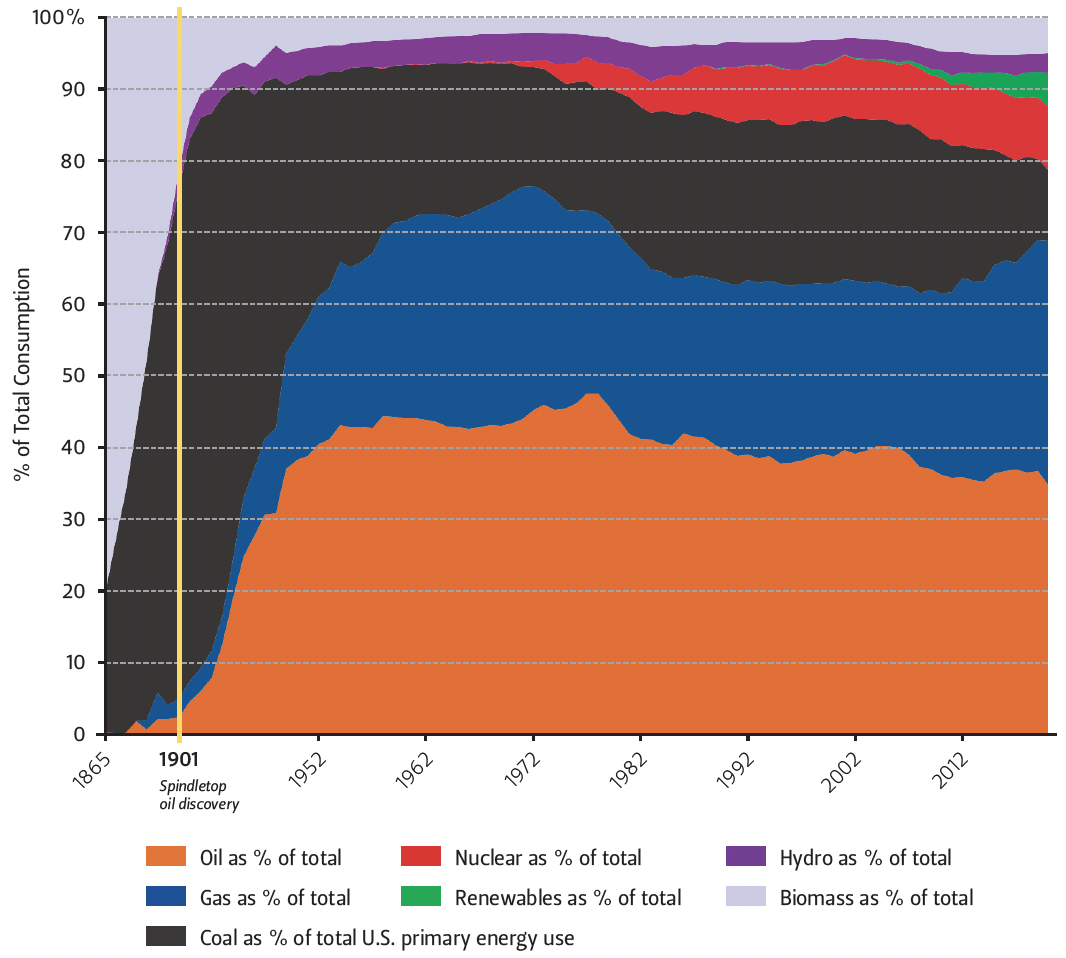
Production from most U.S. oil and gas wells declines rapidly. Accordingly, if produced water was classified as a hazardous waste—causing drilling to decrease and substantial volumes of existing production to be shut-in due to higher disposal costs—U.S. oil and gas supplies available to the market would decrease quickly. Curtailing U.S. domestic production would destabilize global energy markets, which are tightly integrated with the American oil and gas patches. The United States is a global petroleum titan larger than Saudi Arabia or Russia, producing roughly 18% of global oil and liquids output in 2019 and nearly a quarter of the global gas supply, according to the BP Statistical Review of World Energy. Even if OPEC and major global gas exporters could eventually compensate for such large-scale U.S. production losses, doing so would require years of lead time. In the interim, oil and gas price spikes would likely result.
Risk Factor 2: Dramatic Oil Price Increases
Multiple critical global commodities— including staple food grains—often move in close synchronization with oil prices due to the prevalence of petroleum-based agricultural inputs and the use of grains to produce biofuels that compete with and are blended with oil-derived fuels. During the last oil price upswing in 2004-2008, grain price shocks catalyzed unrest in multiple developing countries, including Bangladesh, Egypt, and Haiti.15 While correlation does not necessarily indicate causation, periods of prolonged upward oil price movement have coincided with increases in corn prices over the past 30 years (Figure 3). In turn, corn price updrafts often presage price increases for other staple grains, as consumers substitute them for each other.
Figure 3 — WTI Spot Crude Oil Price vs. Global Benchmark Corn, Rice, and Wheat Prices
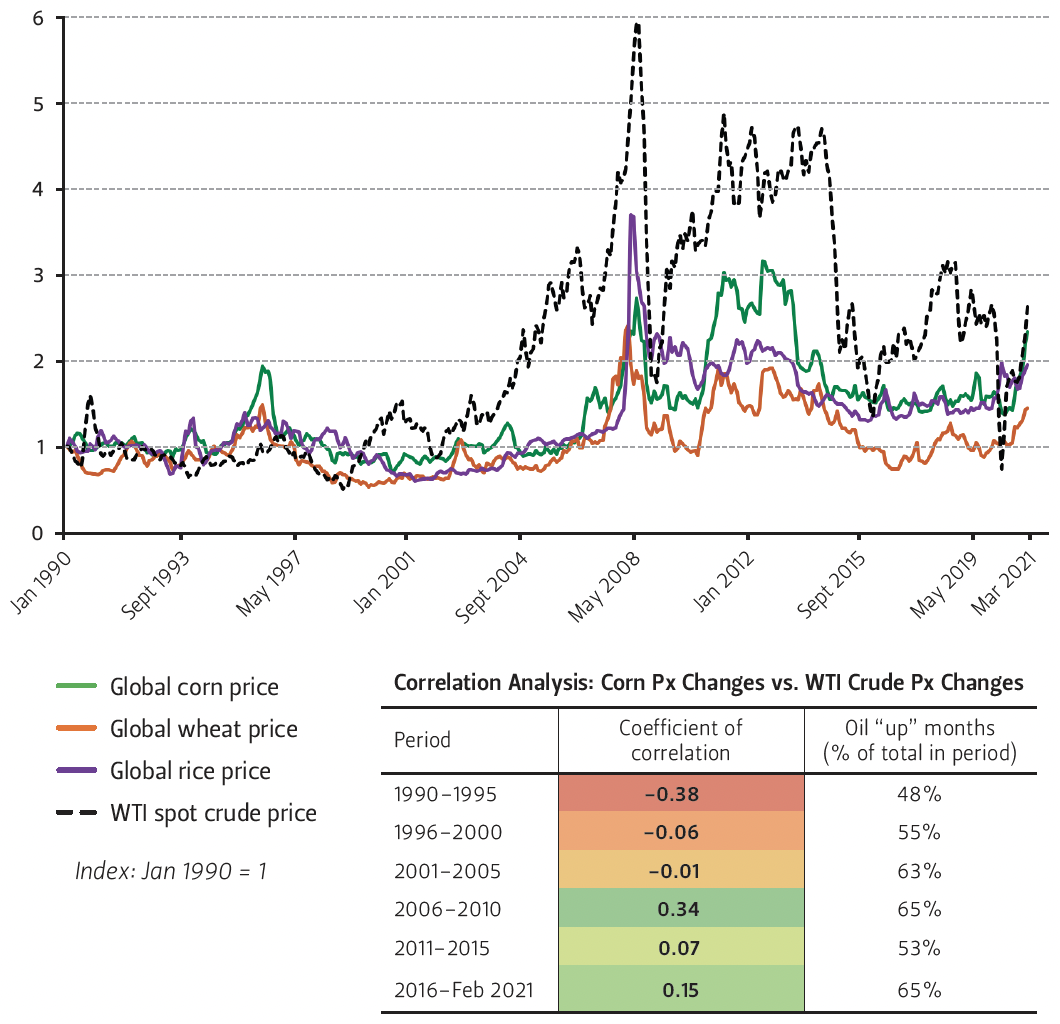
Curtailed U.S. oil and gas production resulting from the classification of produced water as hazardous waste could trigger similar food price spikes. These would likely not just be a problem for the developing world. The COVID-19 pandemic has revealed that many Americans also live on an economic knife’s edge with respect to food security. Scholars from the University of California, Davis and Northwestern University found that in 2020 during the pandemic, approximately 25% of U.S. families surveyed said that food supplies “just didn’t last” and that they could not afford to buy more—a proportion roughly triple the pre-pandemic level.16
The U.S. oil and gas sector and associated value chains directly employ millions, while the energy abundance it facilitates has helped spur a broader industrial and manufacturing revival. Jobs related to hydrocarbon extraction will most likely not be neatly replaced by a transition to non-fossil energy sources. For a narrow but illustrative example, data from BW Research suggests that in the United States, a megawatt-hour of electricity produced from coal supports five times as many jobs as a megawatt produced from wind.17 And a domestic energy market destabilized by a sudden de-oiling and de-gasification would likely discourage overall manufacturing investment (even in sectors not directly tied to oil and gas), which in many instances to date has been predicated on abundant, low-cost energy— including industrial electricity rates that are about half the Eurozone average.
Handicapping the production of unconventional natural gas (both intentionally produced and associated gas) risks sending American consumers back into a higher-price universe akin to the 2000-2005 time frame. There is not yet an alternative source of giga-scale electricity capable of reliably replacing natural gas. Technical innovations will likely chip away at this over time, but the CLEAN Future Act, as drafted, would remove a substantial amount of gas from the system before alternative energy supplies are available at scale.
All else held equal, this would set the stage for significant disruptions in energy availability (a.k.a. blackouts) and electricity price increases that would be fundamentally at odds with President Biden's stated intention to revive and expand U.S. manufacturing activity, reduce emissions, and create well-paying, sustainable jobs.18 Divisive rhetoric and volatile climate diplomacy notwithstanding, America actually reduced CO2 emissions by nearly 10% between 2010 and 2019, despite primary energy consumption rising by roughly 2%—and this reduction was overwhelmingly a product of low-priced natural gas incentivizing consumers to push higher-emissions coal out of the energy supply portfolio.
Energy abundance is a cornerstone of the American industrial and manufacturing sectors, two intertwined domains that have the potential to stabilize American domestic politics if allowed to flourish. The U.S. can “build back better” post-pandemic, and it can build back cleaner as well—but it almost certainly cannot do this without the natural gas abundance that has, for the past decade, conferred input cost and environmental advantages unique among the largest global industrial economies.
“Shock Therapy” Risks Triggering Voter Backlash—and Undermining the Energy Transition
Rapidly removing a baseload energy source before alternatives can viably substitute its energy production at scale risks seriously disrupting a complex and interconnected energy, economic, and political architecture. Put bluntly, energy “shock therapy” risks souring American voters on ambitious energy transition and emissions reduction goals.
There is an increasing risk that energy transition-related political overreach could trigger a massive U.S. political pendulum swing in 2022 and/or 2024. Energy "shock therapy" is a recipe for creating a groundswell of public resistance that then pushes the body politic’s willingness to accept and support meaningful energy transition shifts much further into the future and, in a perverse twist, would magnify the same adverse environmental and societal consequences that the CLEAN Future Act now seeks to avoid.
It bears examining U.S. energy consumption history to obtain a broader, more anchored sense of how consumers respond to energy abundance and scarcity, regulatory mandates, and other external forces. Figure 4 examines U.S. primary energy consumption between 1950 and 2019 in five-year periods, an interval chosen to minimize annual volatility and reflect the time needed for technological and other changes to percolate into energy use patterns.
Four overarching temporal themes emerge. Era 1, from 1950 through 1970, reflects a nearly 250% increase in U.S. domestic natural gas availability. Coal use rose toward the tail end of the interval, but gas dominated for power generation and industrial process heat. Era 2 was ushered in by the 1970 Hubbert’s Peak in domestic oil and gas production, suffered the 1973 Arab Oil Embargo, and transitioned into the stagflation of the early 1980s. It was fundamentally a period of energy insecurity, and coal use experienced a two-decade growth run. This period was the one in which much of the U.S. coal-fired power capacity that was retired during the Shale Boom was built.
Era 3 spanned 1990 to 2005 and saw coal lose favor early with the amendments to the Clean Air Act and then recover during the “go-go” economic growth of President Bill Clinton’s second term. Era 4—which commenced in 2005 and is still unfolding—marks America’s revival as a gas superpower, a trend amply reflected through numerous retirements of aging coal plants and increased gas use. Readers should note the importance of scale: Even with the unprecedented wind and solar boom from 2010 onwards, gas supplied 12 times as much primary energy in the U.S. as wind and solar combined.
In 2019, the high-water mark year for gas, wind, and solar alike, gas still supplied nearly nine times as much energy as wind and solar. The enduring disparity should give pause to any policymaker contemplating measures that would rapidly curtail domestic gas supplies on the assumption that renewables could quickly and seamlessly fill the void.
Figure 4 — Change in U.S. Energy Consumption by Source (Quadrillion BTU)
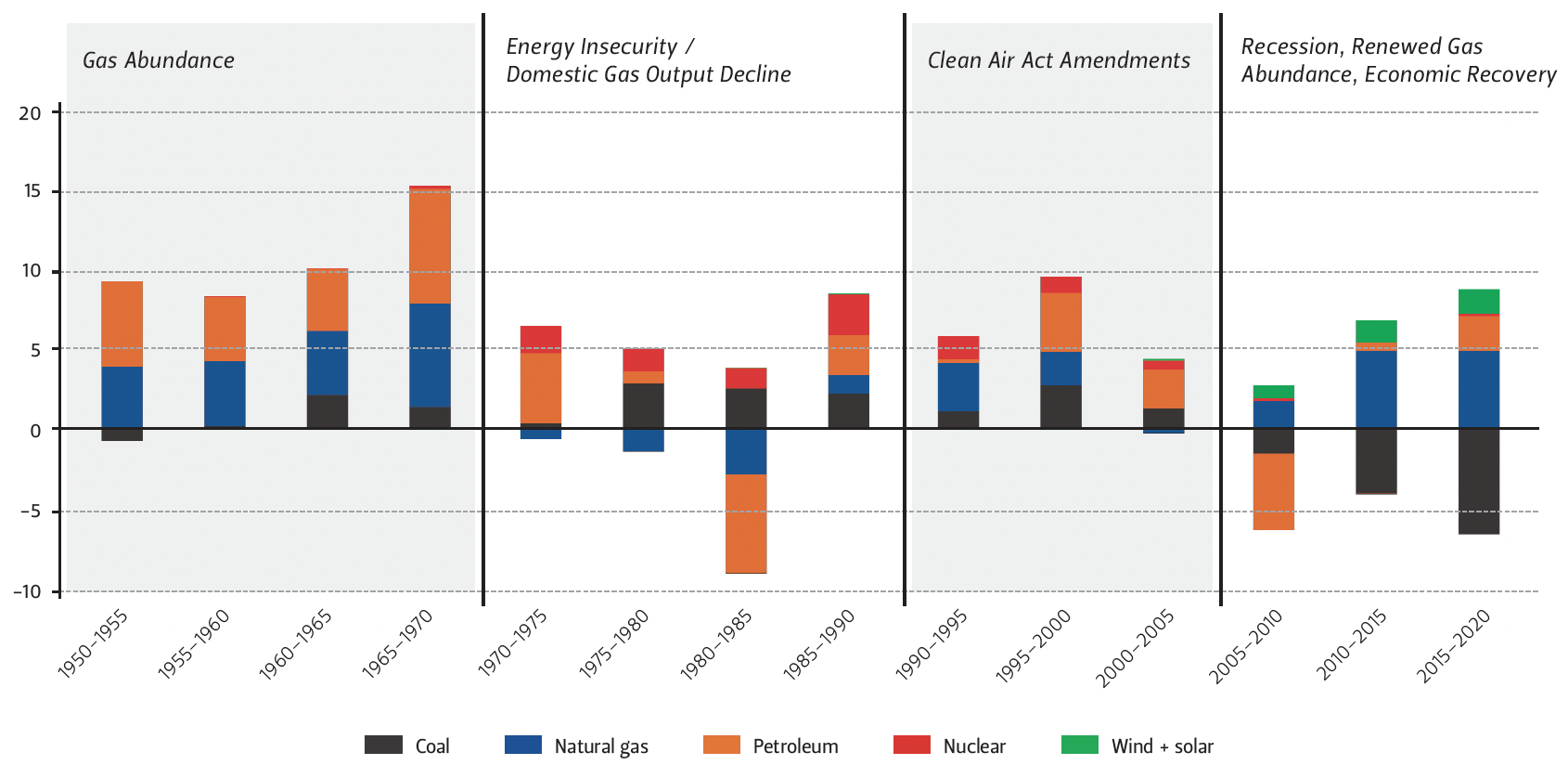
Source EIA, author’s analysis.
Risk Factor 3: Conflicts Between Energy-producing States and the Federal Government
Policies that seek to remove hydrocarbon sources through sudden “shock therapy” rather than an incremental transition also risk sparking severe conflicts between energy-producing states and the federal government. The 2021 legislative session in key energy-producing states already flashes some red warning signs on this front. Recently introduced Texas House Bill 1683 and its companion Senate Bill 1734 offer a stark example, as they seek to prohibit state and local agencies and law enforcement personnel from helping federal authorities enforce any law or regulation that “imposes a prohibition, restriction, or other regulation that does not exist” under Texas state laws pertaining to oil and gas operations.19 The bills did not pass this legislative session, but they are a harbinger of energy-producing states’ likely responses to federal policy measures aimed at curtailing domestic oil and gas production.
State-level measures like H.B. 1683 that became law would raise the specter of de facto regulatory secession from important environmental governance rulesets. If this happened in any state, the precedent would be sufficiently impactful and far-reaching that Washington would have to respond decisively, lest it lose control of its ability to meaningfully regulate energy and environmental policy across the entire country.
Opposition among Texas political figures to federal policy measures perceived as anti-oil and gas comes as no surprise, given that the state produces more oil than any single OPEC member country aside from Saudi Arabia. But several other states—including Alaska, New Mexico, North Dakota, Oklahoma, and Wyoming—produce more oil and gas per capita than Texas does, while others such as Pennsylvania and West Virginia (home to lynchpin Democrat Senator Joe Manchin) have become gas production powerhouses over the past decade and a half (Figure 5).
Figure 5 — Per Capita Oil and Gas Production, by State (Annual Barrels of Oil Equivalent)
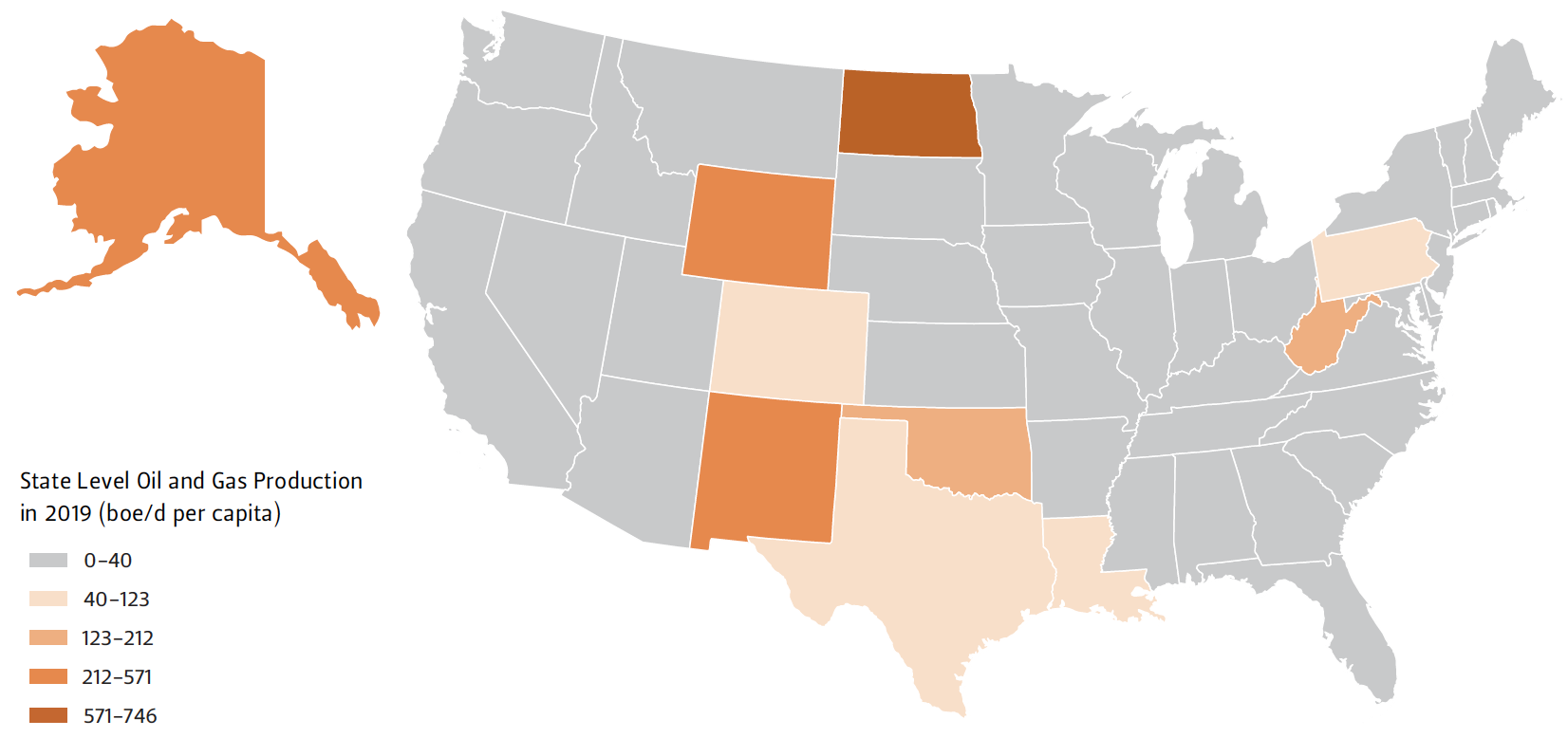
The federal government has robust coercive levers that could be wielded to try and bring states to heel—for instance, withholding certain revenue or assistance flows. Yet, if the economic interests are sufficiently existential at the state level, overt federal coercion would more likely further inflame the situation.
State-level opposition to measures that effectively restrict oil and gas production would be magnified by the critical role oil and gas revenues play in funding K-12 public education and state university systems. For instance, New Mexico’s state budget has, for the past decade, seen revenues generated by oil and gas operations consistently account for approximately one-third of total General Fund revenues (roughly half of General Fund spending supports education).20 Texas, meanwhile, derived approximately $6 billion in K-12 school funds in 2019 from oil and gas activity—roughly a fifth of that year’s total education budget, according to Texas 2036.21 Other producing states such as Colorado and Wyoming also fund substantial portions of their public education budgets through oil and gas revenues. Sudden disruptions to these cash streams would intensify public and political backlash.
Risk Factor 4: Legal Liabilities
If produced water was classified as a hazardous waste, oil and gas producers whose assets were rendered uneconomic would likely bring takings claims against governmental entities associated with the action, especially the EPA. The U.S. Supreme Court has found in regulatory takings cases that “when the owner of real property has been called upon to sacrifice all economically beneficial uses in the name of the common good, that is, to leave his property economically idle, he has suffered a taking.”22 Regulatory takings jurisprudence prominently considers the “investment-backed expectations” that a claimant possesses in its property.23
With respect to Section 625 of the CLEAN Future Act, a 1922 U.S. Supreme Court decision on a Pennsylvania coal mining regulatory dispute is perhaps most on point. The case, Pennsylvania Coal Co. v. Mahon, arose after the state legislature passed the Kohler Act, which effectively forbade coal mining near dwellings and improved property not owned by the coal owner. The court found for the plaintiff coal owner, noting that “For practical purposes, the right to coal consists in the right to mine it” and furthermore, that “[t]o make it commercially impracticable to mine certain coal has very nearly the same effect for constitutional purposes as appropriating or destroying it.”24
While a century has passed since the Kohler Act became law in Pennsylvania, the same basic factors that led the U.S. Supreme Court to find the act unconstitutional could very plausibly apply to the facts that would likely be presented in a contemporary context if classification of produced water as a hazardous waste was to render oil and gas rights and producing assets economically impracticable to operate. The total liability associated with such a decision could potentially amount to trillions of dollars in the aggregate.
Risk Factor 5: Adverse Foreign Policy Consequences
At a fundamental level, the “energy abundance” enjoyed by the United States in recent years is a story of oil and gas abundance. Consider, for instance, (1) how the balance between domestic energy consumption and domestic energy production has transpired in reality versus (2) how it would look if actual consumption had instead occurred with domestic oil and gas output at 2002 levels—the year when the shale revolution began to gain steam (Figure 6).
The vast difference in trajectories— transitioning from a scarcity in the early 2000s to energy abundance in the 2010s—has profoundly influenced U.S. foreign policy. Oil and gas production increases became large enough to offset output losses from entire countries. Some of these were involuntary—for instance, in turmoil-wracked Nigeria and Venezuela. But other instances were highly purposeful maneuvers enabled by the cushion of record domestic oil and gas production.
Figure 6 — U.S. Primary Energy Balance, Actual vs. “No Shale Boom”
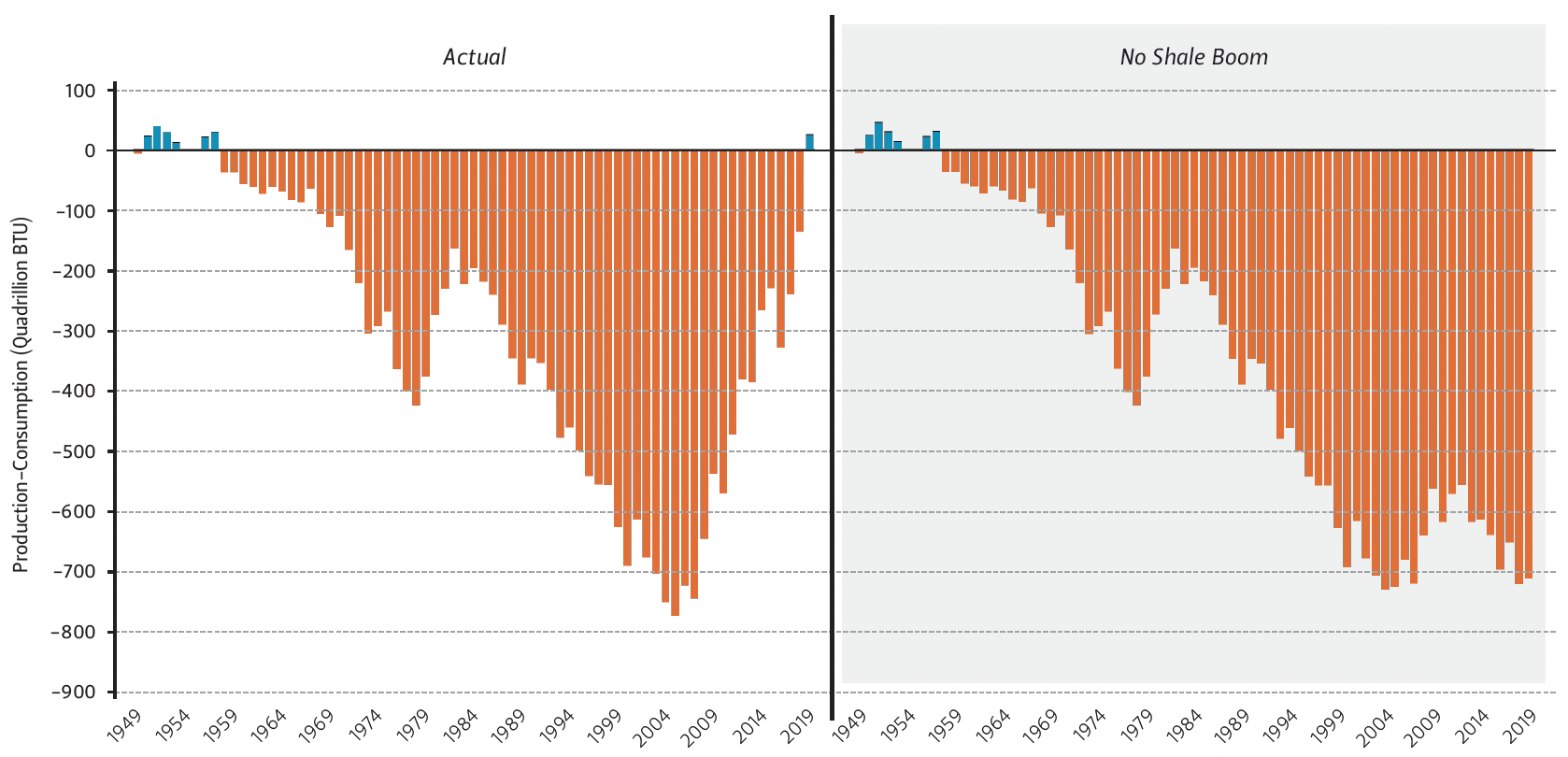
As Meghan O’Sullivan noted in her 2017 book Windfall, “[b]urgeoning U.S. tight oil production was critical in convincing both domestic and international skeptics that sanctions on Iran could be imposed and incrementally tightened—all without sparking an economically debilitating price spike.”25 American oil abundance helped persuade key oil consumers, especially the European Union (EU), but also China, India, Japan, and South Korea, to either actively impose embargo measures—or, in the case of China and India—substantially reduce imports of Iranian crude. Ultimately, the combined pressure front was instrumental in creating the diplomatic leverage that helped incentivize Tehran to agree to the Joint Comprehensive Plan of Action (a.k.a. the Iran nuclear deal) in 2015.
In a pre-shale boom environment, it is very difficult to imagine Washington, much less the EU and other key oil consumers, endorsing the bold geoeconomic act of cutting OPEC’s then second-largest producer almost entirely out of the global oil market. Countries with an energy balance deep in the red are generally less bold and imaginative—a serious matter given the urgent need to manage the global revisionist challenge from China and the regional revisionism of Russia and Iran.
For natural gas, measures that crippled domestic U.S. production would translate into higher energy costs throughout the OECD, make Europe more vulnerable to Russian gas coercion, slow China's transition away from coal by making gas supplies more expensive, and reinforce India's incentives to develop domestic coal resources. The net impact of those last two items alone would probably send the world 15 years into reverse when it comes to emissions reduction progress.
Hamstringing American domestic gas output also eliminates the near-term opportunity to combine gas abundance and carbon taxation to make climate a point of competition with China—likely the only feasible path to generate the leverage necessary to achieve global environmental progress without having to make concessions on a range of geopolitical issues that would leave Asia and the rest of the world less secure.
Finally, significant reductions in U.S. domestic gas production would almost certainly reduce—or even end—liquefied natural gas (LNG) exports. Loss of U.S. LNG exports would imperil, among other things, energy transition and emissions reduction efforts in Japan and South Korea. These key industrial economies (and U.S. treaty allies) predicate a substantial portion of their energy transition plans on the global gas market liquidity enabled by American domestic gas abundance.
Optimizing the CLEAN Future Act’s Produced Water Provisions to Protect Bridge Energy Sources
Incremental energy policy advances that start today but yield their sweetest fruit a few election cycles hence do not offer the instant political gratification that is all too often the present currency of the realm. But for something as complex and pervasively important as the American energy supply portfolio—which touches virtually every aspect of our financial and physical lives— slow and steady is a more successful way to go. “Move fast and break stuff” generally begets dire consequences in the energy space, no matter the fuel concerned.
If Section 625 of the CLEAN Future Act was fully implemented as written and led to the very plausible (and by all appearances, intended) outcome of an EPA review that classified produced water as a hazardous waste, the oil and gas supply impacts would manifest within weeks. And they would be severe. The ultimate oil and liquids supply loss could easily equal (and realistically, double) the nearly 6 million barrel per day disruption caused by the September 2019 drone/missile attack on crude oil processing facilities in Eastern Saudi Arabia. Gas output losses would be commensurate.
The CLEAN Future Act’s produced water language contains multiple provisions that deserve serious consideration—for instance, enhanced groundwater monitoring requirements for oilfield water disposal operations, more intensive reviews of facility siting, and more stringent bonding requirements to ensure the financial wherewithal is on hand when a spill needs to be remediated or facilities decommissioned.26 Section 625 could also be modified to better protect the public interest on at least two other levels. First, it could add a federal requirement that, as a condition of granting state primacy, requires state regulators to comprehensively track and publicly report produced water spills and releases. Second, it could earmark funding for the creation of a “produced water transparency initiative” where samples are periodically taken from oilfield water handling infrastructure in producing areas, analyzed by EPA scientists, delegated state agencies, or independent third-party laboratories, with results then made publicly available in a FracFocus-style format.
While Section 625 is only part of the CLEAN Future Act’s expansive legislation package, classifying produced water as a hazardous waste would very likely induce multi-system disruptions severe enough to prevent the bill from achieving its climate, energy, environmental, and social objectives. Even if incremental change is not en vogue politically, it offers the most effective and just path to transition a United States energy system that underpins multiple life-critical activities and is collectively worth trillions of dollars.
Endnotes
1. CLEAN Future Act (Climate Leadership and Environmental Action for our Nation’s Future Act), H.R. 1512, 117th Cong., Section 101 (2021), https://energycommerce.house.gov/sites/democrats.energycommerce.house.gov/files/ documents/BILLS-117hr1512ih.pdf.
2. Rebecca Dell, “Testimony for U.S. House of Representatives Committee on Energy and Commerce Subcommittee on Environment and Climate Change Hearing on the CLEAN Future Act: Industrial Climate Policies to Create Jobs and Support Working Families,” March 18, 2021, https://docs.house.gov/meetings/IF/IF18/20210318/111348/HHRG-117-IF18-Wstate-DellR-20210318.pdf; Bob Perciasepe, “Testimony for U.S. House of Representatives Committee on Energy and Commerce Subcommittee on Environment and Climate Change Hearing on the CLEAN Future Act: Testimony on Behalf of the Renewable Thermal Collaborative,” March 18, 2021, https://energycommerce.house.gov/sites/democrats.energycommerce.house.gov/files/ documents/Witness%20Testimony_Perciasepe_ECC_2021.03.18. pdf; Kevin Sunday, “Testimony for U.S. House of Representatives Committee on Energy and Commerce Subcommittee on Environment and Climate Change Hearing on the CLEAN Future Act: Testimony on Behalf of the Pennsylvania Chamber of Business and Industry,” March 18, 2021, https://docs.house.gov/meetings/IF/IF18/20210318/111348/HHRG-117-IF18-Wstate-SundayK-20210318.pdf; Jason Walsh, “Testimony for U.S. House of Representatives Committee on Energy and Commerce Subcommittee on Environment and Climate Change Hearing on the CLEAN Future Act: Testimony on Behalf of the BlueGreen Alliance,” March 18, 2021, https://docs.house.gov/meetings/IF/IF18/20210318/111348/HHRG-117-IF18-Wstate-WalshJ-20210318.pdf; Michelle Michot Foss, “Minerals& Materials Supply Chains–Considerations for Decarbonizing Transportation,” Testimony before the U.S. House of Representatives Committee on Energy & Commerce Subcommittee on Energy Hearing on ‘The CLEAN Future Act: Driving Decarbonization of the Transportation Sector,’ May 5, 2021, https://energycommerce.house.gov/sites/democrats.energycommerce.house.gov/files/ documents/Witness%20Testimony_Foss_ENG_2021.05.05.pdf; “Hearing on the CLEAN Future Act: Powering a Resilient and Prosperous America,” March 24, 2021, https://energycommerce.house.gov/committee-activity/hearings/hearing-on-the-clean-future-act-powering-a-resilient-and-prosperous; “Hearing on the CLEAN Future Act: Superfund Proposals to Advance Cleanups, Equity, and Climate Resilience,” May 13, 2021, https://energycommerce.house.gov/committee-activity/hearings/hearing-on-the-clean-future-act-superfund-proposals-to-advance-cleanups.
3. CLEAN Future Act, H.R. 1512, 117th Cong., Section 625 (2021), https://energycommerce.house.gov/sites/democrats.energycommerce.house.gov/files/ documents/BILLS-117hr1512ih.pdf.
4. EPA (U.S. Environmental Protection Agency), “Management of Exploration, Development and Production Wastes: Factors Informing a Decision on the Need for Regulatory Action,” Office of Land and Emergency Management, Office of Resource Conservation and Recovery, April 2019, https://www.epa.gov/sites/production/files/2019-04/documents/management_of_exploration_development_and_production_wastes_4-23-19.pdf; “An Act to amend and reauthorize the Solid Waste Disposal Act,” 94 STAT. 2334 PUBLIC LAW 96-482—OCT. 21, 1980, https://www. govinfo.gov/content/pkg/STATUTE-94/pdf/ STATUTE-94-Pg2334.pdf.
5. EPA, “Management of Exploration, Development and Production Wastes: Factors Informing a Decision on the Need for Regulatory Action,” April 2019, Section 9-1 (“section 2002(b) of RCRA … requires every regulation promulgated under the Act to be reviewed and, where necessary, revised not less frequently than every three years.”) https://www.epa.gov/sites/production/files/2019-04/documents/management_of_exploration_development_and_production_wastes_4-23-19.pdf.
6. Section 625’s header “Closing Loopholes and Ending Arbitrary and Needless Evasion of Regulations” further evinces pursuit of an outcome different than the status quo.
7. EPA, “Legislative and Regulatory Timeline for Crude Oil and Natural Gas Waste,” https://www.epa.gov/hw/legislative-and-regulatory-timeline-crude-oil-and-natural-gas-waste.
8. U.S. share calculated using Energy Information Administration data for primary energy consumption by source, https://www.eia.gov/totalenergy/data/browser/?tbl=T01.03#/?f=A&start=1949&end=2020&charted=1-2-3-5-12; Global share calculated using data from BP Statistical Review of World Energy 2020, https://www.bp.com/en/global/corporate/energy-economics/statistical-review-of-world-energy.html.
9. Michelle Michot Foss, “The ‘Criticality’ of Minerals for Energy Transitions. Hydrocarbons? Yes, Hydrocarbons,” Baker Institute Blog, February 8, 2021, https://bakerinstituteblog.blogs.rice.edu/2021/02/08/the-criticality-of-minerals-for-energy-transitions-hydrocarbons-yes-hydrocarbons/.
10. EPA, “Class II Oil and Gas Related Injection Wells,” https://www.epa.gov/uic/class-ii-oil-and-gas-related-injection-wells.
11. EPA, “Class I Industrial and Municipal Waste Disposal Wells,” https://www.epa.gov/uic/class-i-industrial-and-municipal-waste-disposal-wells.
12. The author thanks his colleague Rachel Meidl for sharing her deep expertise on the regulatory burdens associated with hazardous waste management.
13. Commercial Class II saltwater disposal facilities generally charge $0.50 to $1.00 per barrel of water injected, while Class I wells handling non-hazardous waste such as landfill leachate charge $7.50 to $10.50 per barrel injected. Rates for Class I injection wells permitted for hazardous wastes may be even higher due to their relative scarcity. See, for instance, Viraj deSilva, “PFAS in Landfill Leachate,” SCS Engineers, July 16, 2019, http://www.mowastecoalition.org/resources/Documents/2019%20conference/MWCC2019%20-deSilva%20(SCS)%20-PFAS-July%2016,%202019.pdf.
14. C.E. Clark and J.A. Veil, “Produced Water Volumes and Management Practices in the United States,” Argonne National Laboratory, Environmental Science Division, September 2009, https://www.evs.anl.gov/publications/doc/ANL_EVS__R09_produced_water_volume_report_2437.pdf.
15. Julia Berazneva and David R. Lee, “Explaining the African food riots of 2007–2008: An empirical analysis,” Food Policy 39, (2013): 28-39, https://doi.org/10.1016/j.foodpol.2012.12.007; Orla Ryan, “Food riots grip Haiti,” The Guardian, April 9, 2008, https://www.theguardian.com/world/2008/apr/09/11.
16. Marianne P. Bitler, Hilary W. Hoynes, and Diane Whitmore Schanzenbach, “The social safety net in the wake of COVID- 19,” Brookings Papers on Economic Activity, BPEA Conference Drafts, June 25, 2020, https://www.brookings.edu/wp-content/uploads/2020/06/Bitler-et-al-conference-draft.pdf.
17. Scott Carpenter, “The Challenge Facing Biden’s Green Jobs Agenda? Green Jobs,” Forbes, January 19, 2021, https://www.forbes.com/sites/scottcarpenter/2021/01/19/the-challenge-facing-bidens-green-jobs-agenda-green-jobs/?sh=712d128443ac.
18. “Remarks by President Biden in Press Conference,” March 25, 2021, The White House, https://www.whitehouse.gov/briefing-room/speeches-remarks/2021/03/25/remarks-by-president-biden-in-press-conference/.
19. Relating to the enforcement of certain federal laws regulating oil and gas operations within the State of Texas, Texas H.B. 1683, 87th Legislature (2021-2022), https://capitol.texas.gov/Search/DocViewer.aspx?ID=87RHB016831B&QueryText=%22landgraf%22&DocType=B.
20. “Fueling New Mexico: State Revenue Impacts of New Mexico’s Oil and Gas Industry,” New Mexico Oil and gas Association, 2020, https://d3n8a8pro7vhmx.cloudfront.net/nmoga/pages/131/attachments/original/1610642216/ NMOGA_FuelingNewMexico_2020.pdf?1610642216; “Gov. Lujan Grisham releases FY 2021 executive budget,” Office of the Governor, January 6, 2020, https://www.governor.state.nm.us/2020/01/06/gov-lujan-grisham-releases-fy-2021-executive-budget/; “General Fund Year to Date Revenue Accrual,” New Mexico Department of Finance and Administration, https://www.nmdfa.state.nm.us/board-of-finance/general-fund-and-the-economy/general-fund-year-to-date-revenue-accrual/.
21. “Changing World Oil Markets and the Texas Economy,” Texas 2036, https://texas2036.org/changing-world-oil-markets-and-the-texas-economy/.
22. Lucas v. S.C. Coastal Council, 505 U.S. 1003, 1019, 112 S. Ct. 2886, 2895, 120 L. Ed. 2d 798 (1992).
23. Penn Cent. Transp. Co. v. City of New York, 438 U.S. 104, 124, 98 S. Ct. 2646, 2659, 57 L. Ed. 2d 631 (1978).
24. Pennsylvania Coal Co. v. Mahon, 260 U.S. 393, 414, 43 S. Ct. 158, 160, 67 L. Ed. 322 (1922), Citing Commonwealth v. Clearview Coal Co., 256 Pa. 328, 331, 100 Atl. 820, L. R. A. 1917E, 672.
25. Meghan O’Sullivan, Windfall: How the New Energy Abundance Upends Global Politics and Strengthens America's Power, (New York: Simon & Schuster, 2017), 124.
26. CLEAN Future Act, H.R. 1512, 117th Cong., Section 625 (2021), https://energycommerce.house.gov/sites/democrats.energycommerce.house.gov/files/ documents/BILLS-117hr1512ih.pdf.
This material may be quoted or reproduced without prior permission, provided appropriate credit is given to the author and Rice University's Baker Institute for Public Policy. The views expressed herein are those of the individual author(s), and do not necessarily represent the views of Rice University's Baker Institute for Public Policy.



